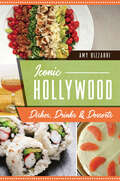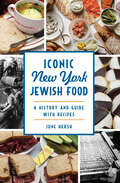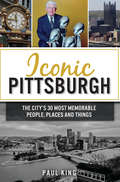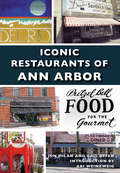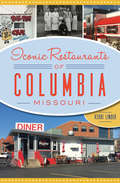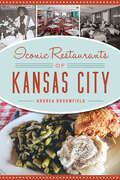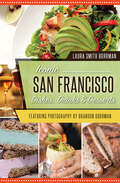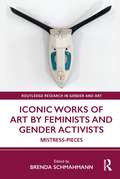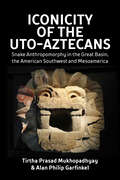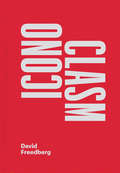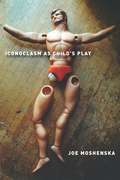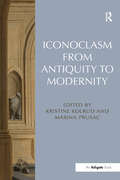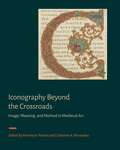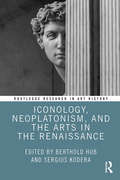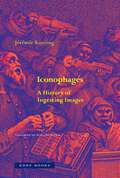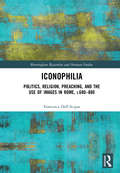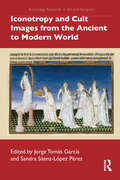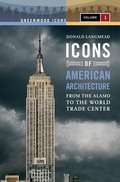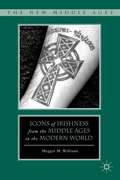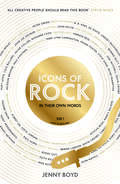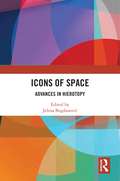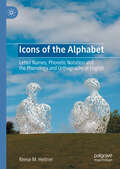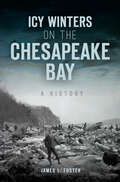- Table View
- List View
Iconic Hollywood Dishes, Drinks & Desserts (American Palate)
by Amy BizzarriRecipes born in the city of starsLos Angeles is a city where film mingles with food. From healthful salads to sweet treats inspired by California's agricultural bounty, the innovative fare mirrors the rise from a sleepy, western outpost to celluloid dream, where food has always played an award-winning role. The minds behind these delicious treasures include a pauper who reinvented himself as a prince, a penniless single mom who perfected a treasured recipe to create an empire, and a guru who provided good vibes and scandal alongside cold-pressed juices. Bake up the Cocoanut Grove's Coconut Strawberry Cream Tarts and sip a Zombie from the first-ever Tiki bar to create a little Hollywood magic in your own kitchen. Amy Bizzarri rolls out the red carpet in celebration of Tinseltown's iconic cuisine.
Iconic New York Jewish Food: A History and Guide with Recipes (American Palate)
by June HershCuisine brought to New York by Jewish immigrants more than a century ago has become some of the most iconic foods associated with the Big Apple. No trip to the five boroughs is complete without a hand-sliced pastrami sandwich at a classic delicatessen or
Iconic Pittsburgh: The City's 30 Most Memorable People, Places and Things
by Paul KingThe Steel City has boasted some of the most famous figures, landmarks and innovations in the country's history. Pittsburgh's past is littered with dozens of fascinating stories behind the icons that define it. Mary Schenley was the city's biggest benefactress of the nineteenth century, gifting the site of the 425-acre park in her name, but her fortune was almost lost when she eloped at the age of fifteen. The first ever call-in radio talk show began at famed KDKA in 1951, inspiring the birth of an entire industry. Mount Washington offers tourists sweeping views of the city today, but it once supplied coal to Pittsburghers and was the site of a sixteen-year underground mine fire. Author Paul King lists the best people, places and things of Pittsburgh's grand history.
Iconic Restaurants of Ann Arbor (Images Of America Ser.)
by Jon Milan Gail Offen Ari WeinzweigWhat is an iconic Ann Arbor restaurant? Ask anyone who has ever spent time there as a student, traveler, or “townie,” and they are likely to name several favorites in an instant. From debating the best place to celebrate or console on football Saturdays to deciding where to eat after the bars close, the choices have always sparked passionate conversation. In Ann Arbor, people are known to have strong feelings about the best places for pizza, coffee, beer, burgers, noodles, and burritos. Although many of the go-to hangouts are long gone, a surprising number still thrive. And there are always a few newcomers coming along to win the hearts of the next generation of diners, nibblers, and noshers. Some are fine restaurants and taverns, and others are lunch counters, diners, carry-outs, and drive-ins—but in each and every case, they are unique and together make up a collection of iconic local eateries.
Iconic Restaurants of Columbia, Missouri (American Palate)
by Kerri LinderColumbia's culinary history is chock-full of restaurants that not only satisfied appetites but also provided gathering places to build community. Gentry's Tavern served wild game along the Boonslick Trail. Hungry and broke students could grab a meal on credit from Ralph Morris at the Ever Eat Café during the Depression. During and after World War II, Ambrose's Café required students to give up their seats to men in uniform. Segregation didn't stop Annie Fisher from making her fortune serving her famous beaten biscuits. These stories and more are as rich as the cinnamon rolls served at Breischs. Join Columbia native Kerri Linder as she shares the stories and memories wrapped around the food of Columbia's iconic restaurants.
Iconic Restaurants of Kansas City (American Palate)
by Andrea BroomfieldGenerations of families and restaurateurs have loyally turned out the delectable foods that made Kansas City the food destination that it is. Opened in 1930, the Infante family's El Nopal at 416 West Thirteenth Street is reputedly the first restaurant to introduce a wider Kansas City audience to Mexican food. The city's beloved Savoy Grill was not only one of Harry S Truman's favorite haunts but also the restaurant where many Kansas Citians remember eating their first lobster dinner. "Amazin' Grace" Harris's tiny Kansas City, Kansas H & M Barbecue kept alive Kansas City's "Paris of the Plains" reputation--for those in the know. Author and native Andrea Broomfield goes on a journey to discover the roots of Kansas City's favorite restaurants.
Iconic San Francisco Dishes, Drinks & Desserts (American Palate)
by Laura Smith BorrmanThe roots of San Francisco's celebrated food and drink culture are as diverse as the city itself. A bountiful ocean, rich soil and ingenious residents combined to create unforgettable and enduring gastronomic legacies. Discover the disputed origins of local specialties like the Chicken Tetrazzini, chop suey and the classic martini, along with the legend behind the creation of Green Goddess Dressing. Learn how the abundance of the bay contributed to classics like the Hangtown Fry and Cioppino. Marvel at the introduction of America's first fortune cookie by Benkyodo Candy Factory and how a lack of refrigeration spawned the iconic Anchor Steam Beer. Pile the guacamole on a Mission Burrito and grab an Its-It for dessert. With classic and modern recipes from beloved establishments, author Laura Smith Borrman brings these and other culinary stories to life.
Iconic Works of Art by Feminists and Gender Activists: Mistress-Pieces (Routledge Research in Gender and Art)
by Brenda SchmahmannIn this book, contributors identify and explore a range of iconic works – "Mistress-Pieces" – that have been made by feminists and gender activists since the 1970s. The first volume for which the defining of iconic feminist art is the raison d’être, its contributors interpret a "Mistress-Piece" as a work that has proved influential in a particular context because of its distinctiveness and relevance. Reinterpreting iconic art by Alice Neel, Hannah Wilke and Ana Mendieta, the authors also offer important insights about works that may be less well known – those by Natalia LL, Tanja Ostojić, Swoon, Clara Menéres, Diane Victor, Usha Seejarim, Ilse Fusková, Phaptawan Suwannakudt and Tracey Moffatt, among others. While in some instances revealing cross influences between artists working in different frameworks, the publication simultaneously makes evident how social and political factors specific to particular countries had significant impact on the making and reception of art focused on gender. The book will be of interest to scholars working in art history, visual studies and gender studies.
Iconic Works of Art by Feminists and Gender Activists: Mistress-Pieces (Routledge Research in Gender and Art)
by Brenda SchmahmannIn this book, contributors identify and explore a range of iconic works – "Mistress-Pieces" – that have been made by feminists and gender activists since the 1970s. The first volume for which the defining of iconic feminist art is the raison d’être, its contributors interpret a "Mistress-Piece" as a work that has proved influential in a particular context because of its distinctiveness and relevance.Reinterpreting iconic art by Alice Neel, Hannah Wilke and Ana Mendieta, the authors also offer important insights about works that may be less well known – those by Natalia LL, Tanja Ostojić, Swoon, Clara Menéres, Diane Victor, Usha Seejarim, Ilse Fusková, Phaptawan Suwannakudt □and Tracey Moffatt, among others. While in some instances revealing cross influences between artists working in different frameworks, the publication simultaneously makes evident how social and political factors specific to particular countries had significant impact on the making and reception of art focused on gender.The book will be of interest to scholars working in art history, visual studies and gender studies.
Iconicity of the Uto-Aztecans: Snake Anthropomorphy in the Great Basin, the American Southwest and Mesoamerica
by Tirtha Prasad Mukhopadhyay Alan Philip GarfinkelUto-Aztecan iconic practices are primarily conditioned by the consciousness of the snake as a death-dealing power, and as such, an animal that displays the deepest fears and anxieties of the individual. The attempt to study a snake simulacrum thus constitutes the basic objective of this volume. A long, all-embracing iconicity of snakes and related snake motifs are evident in different cultural expressions ranging from rock art templates to other cultural artifacts like basketry, pottery, temple architecture and sculptural motifs. Uto-Aztecan iconography demonstrates a symbolic memorial order of emotional valences, as well as the negotiations with death and a belief in rebirth, just as the skin shedding snake reptile manifests in its life cycle.
Iconoclasm
by David FreedbergWith new surges of activity from religious, political, and military extremists, the destruction of images has become increasingly relevant on a global scale. A founder of the study of early modern and contemporary iconoclasm, David Freedberg has addressed this topic for five decades. His work has brought this subject to a central place in art history, critical to the understanding not only of art but of all images in society. This volume collects the most significant of Freedberg’s texts on iconoclasm and censorship, bringing five key works back into print alongside new assessments of contemporary iconoclasm in places ranging from the Near and Middle East to the United States, as well as a fresh survey of the entire subject. The writings in this compact volume explore the dynamics and history of iconoclasm, from the furious battles over images in the Reformation to government repression in modern South Africa, the American culture wars of the early 1990s, and today’s cancel culture. Freedberg combines fresh thinking with deep expertise to address the renewed significance of iconoclasm, its ideologies, and its impact. This volume also provides a supplement to Freedberg’s essay on idolatry and iconoclasm from his pathbreaking book, The Power of Images. Freedberg’s writings are of foundational importance to this discussion, and this volume will be a welcome resource for historians, museum professionals, international law specialists, preservationists, and students.
Iconoclasm As Child's Play
by Joe MoshenskaWhen sacred objects were rejected during the Reformation, they were not always burned and broken but were sometimes given to children as toys. Play is typically seen as free and open, while iconoclasm, even to those who deem it necessary, is violent and disenchanting. What does it say about wider attitudes toward religious violence and children at play that these two seemingly different activities were sometimes one and the same? Drawing on a range of sixteenth-century artifacts, artworks, and texts, as well as on ancient and modern theories of iconoclasm and of play, Iconoclasm As Child's Play argues that the desire to shape and interpret the playing of children is an important cultural force. Formerly holy objects may have been handed over with an intent to debase them, but play has a tendency to create new meanings and stories that take on a life of their own. Joe Moshenska shows that this form of iconoclasm is not only a fascinating phenomenon in its own right; it has the potential to alter our understandings of the threshold between the religious and the secular, the forms and functions of play, and the nature of historical transformation and continuity.
Iconoclasm from Antiquity to Modernity
by Kristine Kolrud Marina PrusacThe phenomenon of iconoclasm, expressed through hostile actions towards images, has occurred in many different cultures throughout history. The destruction and mutilation of images is often motivated by a blend of political and religious ideas and beliefs, and the distinction between various kinds of ’iconoclasms’ is not absolute. In order to explore further the long and varied history of iconoclasm the contributors to this volume consider iconoclastic reactions to various types of objects, both in the very recent and distant past. The majority focus on historical periods but also on history as a backdrop for image troubles of our own day. Development over time is a central question in the volume, and cross-cultural influences are also taken into consideration. This broad approach provides a useful comparative perspective both on earlier controversies over images and relevant issues today. In the multimedia era increased awareness of the possible consequences of the use of images is of utmost importance. ’Iconoclasm from Antiquity to Modernity’ approaches some of the problems related to the display of particular kinds of images in conflicted societies and the power to decide on the use of visual means of expression. It provides a deeper understanding of the mechanisms of the phenomenon of iconoclasm. Of interest to a wide group of scholars the contributors draw upon various sources and disciplines, including art history, cultural history, religion and archaeology, as well as making use of recent research from within social and political sciences and contemporary events. Whilst the texts are addressed primarily to those researching the Western world, the volume contains material which will also be of interest to students of the Middle East.
Iconographic Method in New World Prehistory
by Vernon James Knight Jr.This book offers an overview of iconographic methods and their application to archaeological analysis. It offers a truly interdisciplinary approach that draws equally from art history and anthropology. Vernon James Knight, Jr begins with an historiographical overview, addressing the methodologies and theories that underpin both archaeology and art history. He then demonstrates how iconographic methods can be integrated with the scientific methods that are at the core of much archaeological inquiry. Focusing on artifacts from the pre-Columbian civilizations of North and Meso-American sites, Knight shows how the use of iconographic analysis yields new insights into these objects and civilizations.
Iconography Beyond the Crossroads: Image, Meaning, and Method in Medieval Art (Signa: Papers of the Index of Medieval Art at Princeton University)
by Pamela A. Patton and Catherine A. FernandezThis volume assesses how current approaches to iconology and iconography break new ground in understanding the signification and reception of medieval images, both in their own time and in the modern world.Framed by critical essays that apply explicitly historiographical and sociopolitical perspectives to key moments in the evolution of the field, the volume’s case studies focus on how iconographic meaning is shaped by factors such as medieval modes of dialectical thought, the problem of representing time, the movement of the viewer in space, the fragmentation and injury of both image and subject, and the complex strategy of comparing distant cultural paradigms. The contributions are linked by a commitment to understanding how medieval images made meaning; to highlighting the heuristic value of new perspectives and methods in exploring the work of the image in both the Middle Ages and our own time; and to recognizing how subtle entanglements between scholarship and society can provoke mutual and unexpected transformations in both. Collectively, the essays demonstrate the expansiveness, flexibility, and dynamism of iconographic studies as a scholarly field that is still heartily engaged in the challenge of its own remaking.Along with the volume editors, the contributors include Madeline H. Caviness, Beatrice Kitzinger, Aden Kumler, Christopher R. Lakey, Glenn Peers, Jennifer Purtle, and Elizabeth Sears.
Iconology, Neoplatonism, and the Arts in the Renaissance (Routledge Research in Art History)
by Berthold HubThe mid-twentieth century saw a change in paradigms of art history: iconology. The main claim of this novel trend in art history was that renowned Renaissance artists (such as Botticelli, Leonardo, or Michelangelo) created imaginative syntheses between their art and contemporary cosmology, philosophy, theology, and magic. The Neoplatonism in the books by Marsilio Ficino and Giovanni Pico della Mirandola became widely acknowledged for its lasting influence on art. It thus became common knowledge that Renaissance artists were not exclusively concerned with problems intrinsic to their work but that their artifacts encompassed a much larger intellectual and cultural horizon. This volume brings together historians concerned with the history of their own discipline – and also those whose research is on the art and culture of the Italian Renaissance itself – with historians from a wide variety of specialist fields, in order to engage with the contested field of iconology. The book will be of interest to scholars working in art history, Renaissance history, Renaissance studies, historiography, philosophy, theology, gender studies, and literature.
Iconophages: A History of Ingesting Images
by Jérémie KoeringAn unprecedented art-historical account of practices of image ingestion from ancient Egypt to the twentieth centuryEating and drinking images may seem like an anomalous notion but, since antiquity, in the European and Mediterranean worlds, people have swallowed down frescoes, icons, engravings, eucharistic hosts stamped with images, heraldic wafers, marzipan figures, and other sculpted dishes. Either specifically made for human consumption or diverted from their original purpose so as to be ingested, these figured artifacts have been not only gazed upon but also incorporated—taken into the body—as solids or liquids.How can we explain such behavior? Why take an image into one&’s own body, devouring it at the risk of destroying it, consuming rather than contemplating it wisely from a distance? What structures of the imagination underlie and justify these desires for incorporation? What are the visual configurations offered up to the mouth, and what are their effects? What therapeutic, religious, symbolic, and social functions can we attribute to these forms of relations with icons? These are a few of the questions raised in this investigation into iconophagy.Iconophages aims to retrace, for the first time, the history of iconophagy. Jérémie Koering examines this unexplored facet of the history of images through an interdisciplinary approach that ranges across art history, cultural and material history, anthropology, philosophy, and the history of the body and the senses. He analyzes the human investment, in terms of culture and imagination, at stake in this seemingly paradoxical way of experiencing images. Beyond the hidden knowledge unearthed here, these pages bring to light a new way of understanding images, just as they illuminate the occasionally outlandish relations we maintain with them.
Iconophilia: Politics, Religion, Preaching, and the Use of Images in Rome, c.680 - 880 (Birmingham Byzantine and Ottoman Studies #27)
by Francesca Dell'AcquaBetween the late seventh and the mid-ninth centuries, a debate about sacred images – conventionally addressed as ‘Byzantine iconoclasm’ – engaged monks, emperors, and popes in the Mediterranean area and on the European continent. The importance of this debate cannot be overstated; it challenged the relation between image, text, and belief. A series of popes staunchly in favour of sacred images acted consistently during this period in displaying a remarkable iconophilia or ‘love for images’. Their multifaceted reaction involved not only council resolutions and diplomatic exchanges, but also public religious festivals, liturgy, preaching, and visual arts – the mass-media of the time. Embracing these tools, the popes especially promoted themes related to the Incarnation of God – which justified the production and veneration of sacred images – and extolled the role and the figure of the Virgin Mary. Despite their profound influence over Byzantine and western cultures of later centuries, the political, theological, and artistic interactions between the East and the West during this period have not yet been investigated in studies combining textual and material evidence. By drawing evidence from texts and material culture – some of which have yet to be discussed against the background of the iconoclastic controversy – and by considering the role of oral exchange, Iconophilia assesses the impact of the debate on sacred images and of coeval theological controversies in Rome and central Italy. By looking at intersecting textual, liturgical, and pictorial images which had at their core the Incarnate God and his human mother Mary, the book demonstrates that between c.680–880, by unremittingly maintaining the importance of the visual for nurturing beliefs and mediating personal and communal salvation, the popes ensured that the status of sacred images would remain unchallenged, at least until the Protestant Reformation in the sixteenth century.
Iconotropy and Cult Images from the Ancient to Modern World (Routledge Research in Art and Religion)
by Jorge Tomás GarcíaThe book examines the process of symbolic and material alteration of religious images in antiquity, the middle ages and the modern period. The process by which the form and meaning of images are modified and adapted for a new context is defined by a large number of spiritual, religious, artistic, geographical or historical circumstances. This book provides a defined theoretical framework for these symbolic and material alterations based on the concept of iconotropy; that is, the way in which images change and/or alter their meaning. Iconotropy is a key concept in religious history, particularly for periods in which religious changes, often turbulent, took place. In addition, the iconotropic process of appropriating cult images brought with it changes in the materiality of those images. Numerous accounts from antiquity, the middle ages and the modern period detail how cult images were involved in such processes of misinterpretation, both symbolically and materially.The book will be of interest to scholars working in art history, visual culture and religious history.
Icons Of American Architecture: From the Alamo to the World Trade Center
by Donald LangmeadThis two-volume encyclopedia of "iconic" examples of American architecture, part of the Greenwood Icons series, discusses 24 of the most memorable structures such as Alcatraz Prison, the Empire State Building and the Washington Monument. Langmead (architecture and design, U. of South Australia) explains the historical significance of each icon by exploring the reasons why it was built and how it became an icon. He provides an architect's view of the unique features of each structure and even provides details on the costs and challenges of construction. He provides plenty of illustrations and photographs of these icons-the images of the Golden Gate Bridge while under construction are particularly striking-and he includes a glossary that makes this reference equally accessible to architectural students and general readers. Annotation ©2009 Book News, Inc., Portland, OR (booknews.com)
Icons Of Irishness From The Middle Ages To The Modern World
by Maggie M. WilliamsFrom majestic Celtic crosses to elaborate knotwork designs, visual symbols of Irish identity at its most medieval abound in contemporary culture. Consdering both scholarly and popular perspectives this book offers a commentary on the blending of pasts and presents that finds permanent visualization in these contemporary signs.
Icons of Rock: In Their Own Words
by Jenny BoydThe Creative Process Behind Rock Music#1 New Release in Actor, Entertainer Biographies, and SongwritingWhat inspires the heart, mind, and soul of so many famous rock stars? Human behavior psychologist and 1960s icon Jenny Boyd explores the artistic drive responsible for creating your favorite songs.A glimpse into the creative power of music. Ever since the Beatles’ British Invasion, numerous rock bands and singers have created albums that still have many fans’ love and devotion today. Was it raw talent, or was there something below the surface that transformed these dreamers into Hollywood legends? Icons of Rock invites music lovers to discover the truth behind their favorite artists and how they created the best songs of all time. Investigating the psychology and chemistry behind artistic inspiration, you will find how much an unconscious influence can change not only one person’s life, but the entire world.Rock legends share their inspirational tips for music success. Having experienced a life full of rock and roll, author Jenny Boyd explores the psychology of rock stars not just from a scientific point, but also from the musicians themselves. Inside, you’ll find rock and roll biographies full of what drove your favorite singers and bands into stardom. Featuring interviews and inspiring stories from Stevie Nicks, Ringo Starr, Keith Richards, and more, discover what makes a rock star and how you can find your own creative success by listening to your inner muse.Inside Icons of Rock, you’ll also discover:Why the unconscious is the key to successWays musicians have nurtured their creative processHow peak experiences can manifest in songwriting and concertsIf you liked The Singers Talk, Jennifer Juniper, or Self-Belief Is Your Superpower, you’ll love Icons of Rock.
Icons of Space: Advances in Hierotopy
by Jelena BogdanovićIcons of Space: Advances in Hierotopy brings together important scholars of Byzantine religion, art, and architecture, to honour the work of renowned art historian Alexei Lidov. As well as his numerous publications, Lidov is well known for developing the concept of hierotopy, an innovative approach for studying the creation of sacred spaces. Hierotopy and the related concepts of ‘spatial icons’ and ‘image-paradigms’ emphasize fundamental questions about icons, including what defines them as structures, spaces, and experiences. Chapters in this volume engage with the overarching theme of icons of space by employing, contrasting, and complementing methods of hierotopy with more traditional approaches such as iconography. Examinations of icons have traditionally been positioned within strictly historical, theological, socio-economic, political, and art history domains, but this volume poses epistemological questions about the creation of sacred spaces that are instead inclusive of multi-layered iconic ideas and the lived experiences of the creators and beholders of such spaces. This book contributes to image theory and theories of architecture and sacred space. Simultaneously, it moves beyond colonial studies that predominantly focus on questions of religion and politics as expressions of privileged knowledge and power. This book will appeal to scholars and students of Byzantine history, as well as those interested in hierotopy and art history.
Icons of the Alphabet: Letter Names, Phonetic Notation and the Phonology and Orthography of English
by Reese M. HeitnerThis book examines the names by which we refer to the letters of the English alphabet, arguing that these letter names provide unrivalled insights into the phonological structure of English, present and past, as well as the many peculiarities of English pronunciation and spelling. Classified either as contronyms, ambinyms or tautonyms, the modern phonological profiles of our ancient Semitic letter names reveal what is unique to English, what is fundamental to language and how letter names emerge as the semiotic product of interchanging languages combined with intralanguage change. This volume promises a much more extensive and deeper linguistic treatment of English letter names than has previously been attempted. It will be of particular interest to students and scholars of historical linguistics, phonology and orthography, the history of English, semiotics, and language and literacy teaching.
Icy Winters on the Chesapeake Bay: A History (Disaster)
by James L. FosterSailing on the Chesapeake Bay's myriad inlets in summer, it is hard to imagine that, come January, icebreakers may be plowing the waters you cruised in July. When portions of the Great Shellfish Bay are iced up, the flow of commerce is impeded. At the turn of the nineteenth century, with the center of the new nation's government established it its arms, a frozen Bay meant that the United States' emergence to a status on par with the foremost nations of the world might be painfully slow. James Foster chronicles the disasters and pitfalls, large and small, that come with the coldest of winters.
